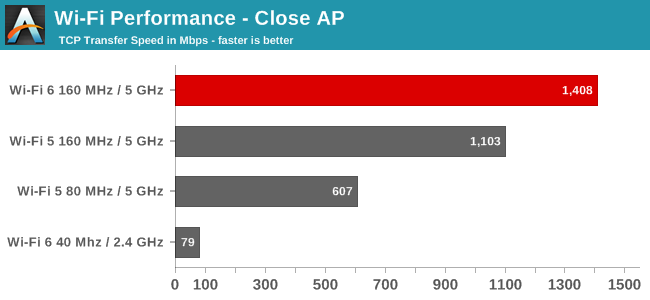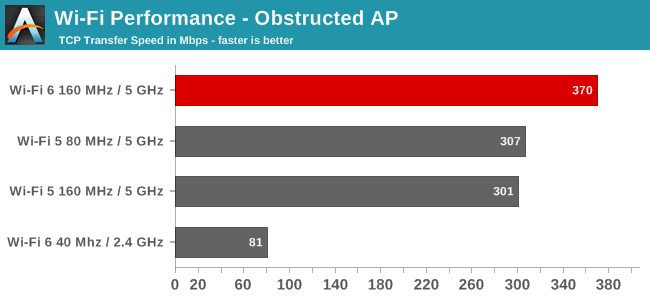AT 101: Wi-Fi 6 And Why You Want It
by Brett Howse on February 12, 2020 8:00 AM ESTPerformance
In order to achieve maximum performance, the latest Wi-Fi 6 standard leverages 1024-level QAM, but depending on the signal strength and quality it will scale down as needed, so to achieve the best performance very high signal to noise ratios are going to be required. Since 5 GHz is attenuated dramatically when it has to go through walls, if you need maximum Wi-Fi performance be aware that you are going to want your wireless router as close to the end device as possible. Luckily that is not an issue in our case, since the router is in the same room when testing for maximum performance, but we’ll also evaluate it in less than ideal scenarios as well.
Wi-Fi 5 vs Wi-Fi 6 – Close AP
First up we’ll test the TCP performance when the Access Point is in the same room as the client.

The performance advantages of Wi-Fi 6 are clear. With the access point in the same room, the SNR is very good and the new 802.11ax standard can really shine. With 1024 QAM and 160 MHz channels, the performance is over twice as fast as the outgoing Wi-Fi 5 with 256 QAM and 80 MHz channels. It is very impressive to see a typical 2x2:2 connection well over the Gigabit barrier, and even though the AX200 network card is the first generation, Intel has already done a fantastic job tuning it. The theoretical maximum transfer rate with 160 MHz channels and 1024 QAM is around 1200 Mbps per connection, so a 2x2 can in theory hit around 2.4 Gbps, meaning there's still room for improvement. Since 802.11ax also can be used on the 2.4 GHz frequency, unlike 802.11ac, the same test was also done on 2.4 GHz, and the results were disappointing. 2.4 GHz can still offer 40 MHz channels, but it doesn’t seem like the AX200 could take advantage of any of that. For reference, the wireless adapter in the laptop was reporting -21 dBm, which is a strong signal, which makes sense since the AP is almost right next to the laptop.
Wi-Fi 5 vs Wi-Fi 6 – Reduced Signal
Moving the laptop further away, and adding several walls and doors in the way to attenuate the signal, the same scenarios were again tested.

With some walls in the way, 5 GHz gets attenuated quite dramatically, and the SNR in the second location was -78 dBm. With such a low signal, the Wi-Fi 6 connection wasn’t able to take advantage of the 1024-level QAM and would have had to drop down to a much lower set, reducing the number of bits per tone, and even though the total channel bandwidth was still 160 MHz, it was only marginally faster on 802.11ax than 802.11ac 80 MHz. 2.4 GHz is not as impacted by walls, and as such was able to maintain the same transfer rate, even though it was still quite a bit slower.
So the results are clear. Wi-Fi 6 can offer a significantly higher level of throughput than Wi-Fi 5, but in order to do so, it needs a strong signal. The Wi-Fi 6 still outperformed the Wi-Fi 5 in the second test with an attenuated signal, but the performance gain was minimal. 2.4 GHz still offers the best signal strength, and therefore would be able to connect further away, and through more obstacles, but doesn’t offer anywhere near the performance of the 5 GHz range. It will be interesting to see the Wi-Fi 6E devices with 6 GHz support when they launch. It will open up Wi-Fi to a wider set of frequency choices, but will offer even less range.










149 Comments
View All Comments
PyroHoltz - Monday, February 17, 2020 - link
This was my understanding as well, AX = full duplexthomasg - Thursday, March 5, 2020 - link
802.11ax is NOT full-duplex.No practical full-duplex radio system exists at this point in time.
thomasg - Thursday, March 5, 2020 - link
You might have mistaken the use of OFDMA as multiple-acces scheme, but OFDMA does not make it full-duplex, it still is entirely and strictly half-duplex.jeads - Tuesday, April 6, 2021 - link
AX is NOT full duplex, its still half duplex. There is talk, but none that I've seen yet, of AX routers using 4x4 antenna. Most consumer routers are still 2x2 (dual band), or 3x3 (tri-band). 4x4 (quad band?), while not true full duplex, will emulate as much.Vorl - Wednesday, February 19, 2020 - link
You also forgot to mention that it's shared. your WIFI router can go 3.6gb/s, but your devices even in a perfectly isolated environment all have to share that bandwidth. You don't get 3.6gb/s to each device.Gasaraki88 - Thursday, February 13, 2020 - link
It sounds faster on paper. If you ACTUALLY look at the speed of wifi on the AC 5GHz band with 2 of the same AC routers connected to each other, it is not faster than hard wire gigabit connection. Look at some router reviews.PEJUman - Thursday, February 13, 2020 - link
this is just one of those rare inflection points (fast ethernet with 802.11n was similiar), which brought gigabit ethernet into mainstream.I have been running 10 Gb ethernet on copper, mixed cat 5e and '7' + Wifi 5 (802.11AC) network in the house for the past 4 years, if you are patient, you can find deals on 10 Gb stuff here and there. Market acceptance on 10 Gb is still quite slow, but I am hoping 5 or 2.5 Gb will be better at getting down to affordable price points.
azfacea - Saturday, February 15, 2020 - link
wow did u just compare fast ethernet to 802.11n ?? one of the most ignorant comments i have read in all of internet. u have no idea what you are talking about gigabit ethernet existed in mainstream (sub 1000$ desktop) in 1999. 802.11n wasnt in the mainstream until no less than a decade after thatPEJUman - Monday, February 17, 2020 - link
gigabit ethernet existed, but gigabit routers does not, at least not at the affordable, mainstream price point. It is not until 'n' that you get gigabit for essentially no premium.yetanotherhuman - Friday, February 14, 2020 - link
Nah, most access points only have a 1Gbit link, and latency and packet loss are always going to be shit on wifi compared to a wired connection.Also, 2.5, 5, 10 and 40 Gbps Ethernet have been A Thing for a while if you go out of your way.